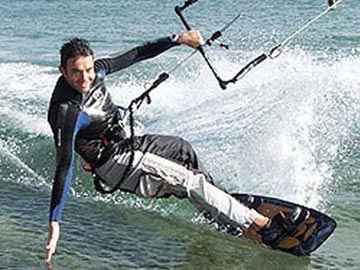|
|
Kitesurfing: Going Beyond The Basics
Released on: July 22, 2010, 5:44 am
Advanced kitesurfing is all about the various interactions between the three main elements of the sport: your body, the board and the kite (as well as the wind). Once you have mastered each of these areas separately, it's time to take your skills to the next level by exploring how each element combines with the others and by learning new techniques that will open the way to new tricks and stunts or simply a greater sense of freedom. Kitesurfing techniques: dealing with underpowered situations Picture this: you have been enjoying a wonderful day's kitesurfing and are currently a couple of miles from the coast - so you have plenty of space for your crazy stunts - when, suddenly, the wind drops. You have now been officially introduced to underpowered kitesurfing. A situation of underpowered kitesurfing is one when the wind drops to a level that makes it very hard (if not impossible) to sustain both speed and power on your kite. Without these two elements, you are out of traction; and, without traction, you are stuck.
If you know there is a possibility of running into an underpowered situation, you might want to use longer lines, which will help you squeeze a little more power out of your kite. If everything fails, you can use your kite to help you paddle your way to the coast. Kitesurfing workshop with James Boulding Practice makes perfect, but there is nothing like the advice of a true professional to take your skills to the next level. James Boulding is one of the top 20 kitesurfers in the world, and Exelement (a company known for setting up extreme experiences such as zorbing and bungee jumping) has invited him to give the first of a new series of kitesurfing workshops. This class is tailored to those riders who have mastered the basics and are looking to take their surfing to the next level. Come to Rye on 25th July and enjoy a kitesurfing course that will change the way you surf. Contact Details: 21 Wilbury Grove
|
|


 You've launched your kite, got comfortable on your board and
even got the timing for a proper heel-jibe turn sussed out. Now, you
wonder, what's next? Kitesurfing may be a relatively new sport, but it
has enough depth and variety to keep your feet glued to the board and
your hands strapped to the handle for a long time. Once you've
mastered the basic skills of handling your kite, your body and your
board, it's time to get involved with the more interesting aspects of
this fantastic sport.
You've launched your kite, got comfortable on your board and
even got the timing for a proper heel-jibe turn sussed out. Now, you
wonder, what's next? Kitesurfing may be a relatively new sport, but it
has enough depth and variety to keep your feet glued to the board and
your hands strapped to the handle for a long time. Once you've
mastered the basic skills of handling your kite, your body and your
board, it's time to get involved with the more interesting aspects of
this fantastic sport. If you ever find yourself in this kind of situation, there are several techniques
you can apply to get to the shore as quickly as possible. Firstly, when you realise
an underpowered situation is arising, try to get as much power as you can from your
kite. There are several things you can do to achieve this: first, make sure you use
only the fixed loop (rather than the chicken loop) until the wind picks up again;
second, move the kite constantly to produce power and speed by using the figure-8
pattern or the sine-wave pattern; third, be mindful of the position of your body
while you are surfing in an underpowered situation - bend your knees and shift your
body near the mid-point of your board to reduce resistance and make the most of the
little power you can gather.
If you ever find yourself in this kind of situation, there are several techniques
you can apply to get to the shore as quickly as possible. Firstly, when you realise
an underpowered situation is arising, try to get as much power as you can from your
kite. There are several things you can do to achieve this: first, make sure you use
only the fixed loop (rather than the chicken loop) until the wind picks up again;
second, move the kite constantly to produce power and speed by using the figure-8
pattern or the sine-wave pattern; third, be mindful of the position of your body
while you are surfing in an underpowered situation - bend your knees and shift your
body near the mid-point of your board to reduce resistance and make the most of the
little power you can gather.